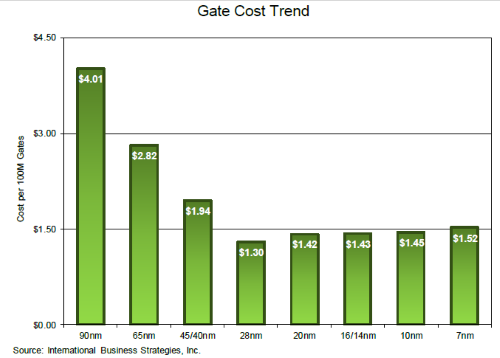$58 seems really high for the A9.
TLDR: That was the old BOM of the A9+External Qualcomm Modem. Newer BOM price of just the CPU is $22 and the modem is $15 for we got a new datapoint due to the iPhone SE being released 7 months later after the iPhone 6s
SM625 said:
And yet apple is able to get A9 chips for $58. Who actually believes that the price of A10 is going to be 30% higher with 30% more transistors? I bet it will be the same $58 +/- 5.
That is the price estimate for the SOC+External Qualcomm Modem for the iPhone 6s which came out in 9/2015, the price estimate for BOM is IHS which specializes in for they do BOM for some big name devices as a free marketing but they make their money figuring out this data as a contracting business, I want to build X, before I try to build X I hire IHS to figure out my estimated BOM and possible ways to make it cheaper or find new suppliers.
This number is now out of date since we have a newer datapoint with the iPhone SE. The iPhone SE uses the same CPU as the iPhone 6s and was released in 4/2016 (aka 7 months later) and when IHS did the breakdown they separated soc and modem, with the soc being valued at $22.00 and the modem being $15 (more on the modem later). If I were to guess the full reasons why the price reduction of these two parts is due to better yields, and the R&D for chip design being already paid and thus it is just the material cost of making the soc.
The same firm who did the price estimate for the Iphone 6s puts the Samsung Galaxy 7 Qualcomm 820 price estimate at $62. Remember with the 820 you get soc+modem on the same silicon.
Now with the galaxy 6 edge which uses the exynos cpu that was competing with the Qualcomm 810 the cpu bom was $29.50 and the modem bom was $15, note this modem with the Galaxy 6 edge is the same modem used by Apple on the Iphone 6s.
If you were just to buy the modem by itself it would be about $15 based on looking at the breakdown for the iPhone SE (the small 4" with A9 processor) making the total for the combo being $37.00 (aka a price reduction of 21). That said this comparison is not quite the same for the iPhone SE modem is the same one used by the iPhone 6 but not the newer 6s which is the qualcomm MDM9625M, the iphone 6s uses the newer qualcomm MDM9635M. But since IHS listed the newer model of modelm the MDM9635M also the same cost on the Galaxy 6 edge I bet the total price for a modem is around $15.
I have no clue why apple went with the MDM9625M for the iPhone SE since the newer chip takes up less size, uses less power, and has more bands and a greater max download speed. If I were to guess the reason is Qualcomm is trying to dump their very old MDM9625M and gave apple a discount compared to retail to unload inventory, or Apple had already accrued excess inventory of the MDM9625M and they wanted a phone / device to get rid of these possible theoretical excess modems.
----
Remember in the near future that Intel will be supplying many of the iPhone modems as long as the phone are not the verizon or china models which will retain the qualcomm chips. (Though some of the GSM carriers Apple may still go with qualcomm in some markets). Thus the modem price will likely go down, or stay at roughly the same price due to multiple suppliers and intel and qualcomm competing against each other for this business.
Thus to sum it all up, the soc / cpu costs for Apple is anywhere from $22 to $45 dollars plus an additional $15 for modem.



